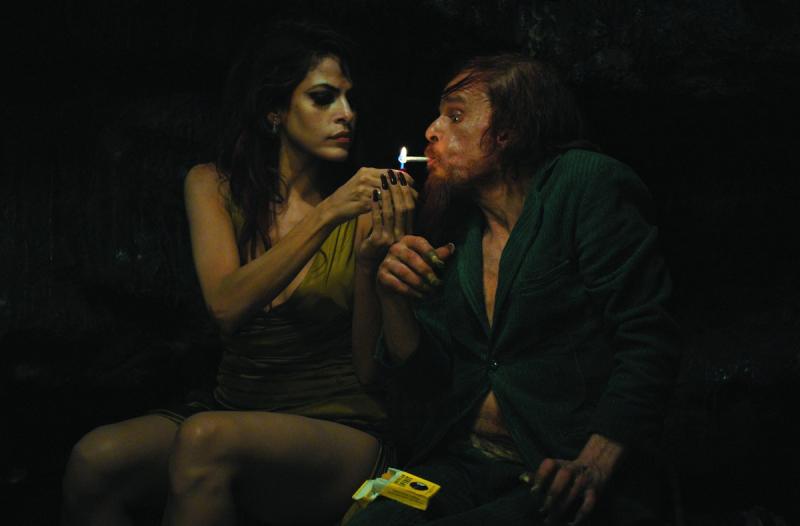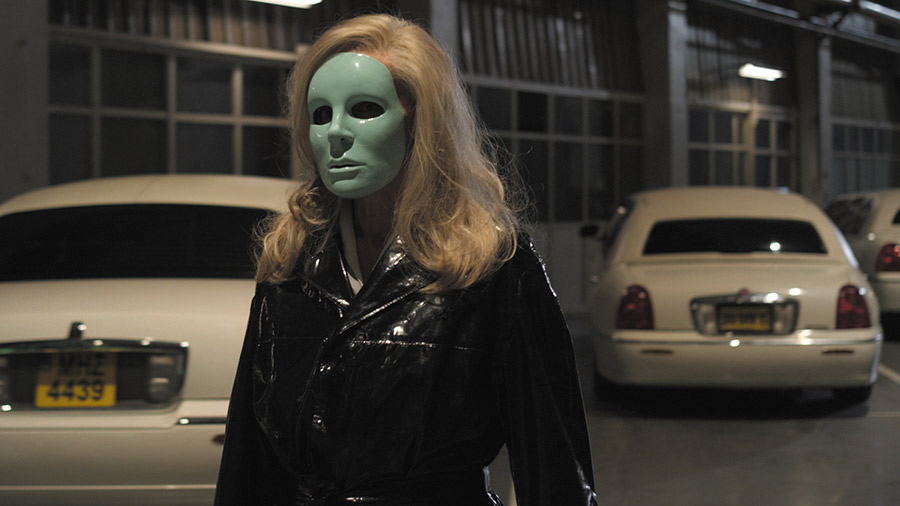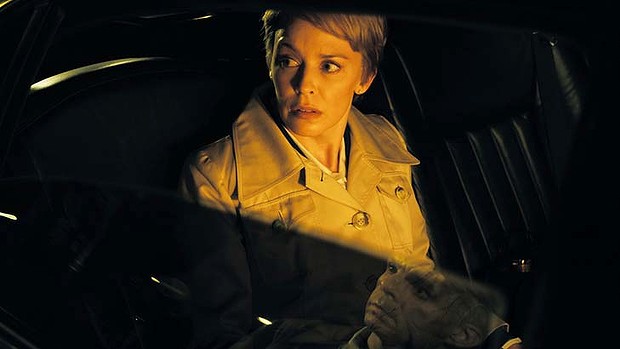Holy Motors | reviews, news & interviews
Holy Motors
Holy Motors
The whole world really is a stage in Leos Carax’s comedic curio

Stop me if you know this one. What do you get if you combine Gallic absurdity with a pristine, pouting Eva Mendes and Kylie as a suicidal chanteuse? The answer, it turns out, is gloriously unpredictable entertainment – by turns satirical, melancholy and effervescently eccentric.
The short prologue sees the film’s French director, Leos Carax, fumbling blindly about a hotel room, eventually finding a hidden door amongst a tree-lined wall. The door contains the lock for a key which is (of course) his finger. Still pyjama-clad, he enters to find himself in a cinema, looking out over the audience. Film, Carax seems to be saying, is a dream, conjured by the mind of the dreamer - and here is my dream.
 Holy Motors gives us a day in the life of a singular performer Monsieur Oscar (regular Carax collaborator Denis Lavant). He’s an actor, commissioned to take on a series of diverse and bizarre assignments, nine in total, for a mysterious organisation known only as The Agency (represented here by a brief appearance from Michel Piccoli). The limo’s driver Céline (Edith Scob) provides company and assistance. Its interior acts as a dressing room. Oscar starts the day posing as a tramp and will end it returning to an extraordinary domestic arrangement. Along the way, he’ll perform a hit, act the father to a teenage daughter and flex his motion capture muscle for a video game lovemaking sequence (pictured above right).
Holy Motors gives us a day in the life of a singular performer Monsieur Oscar (regular Carax collaborator Denis Lavant). He’s an actor, commissioned to take on a series of diverse and bizarre assignments, nine in total, for a mysterious organisation known only as The Agency (represented here by a brief appearance from Michel Piccoli). The limo’s driver Céline (Edith Scob) provides company and assistance. Its interior acts as a dressing room. Oscar starts the day posing as a tramp and will end it returning to an extraordinary domestic arrangement. Along the way, he’ll perform a hit, act the father to a teenage daughter and flex his motion capture muscle for a video game lovemaking sequence (pictured above right).
Oscar’s third assignment sees him return to the exuberantly antisocial Monsieur Merde, whom some may remember (indeed if you’ve seen him you won’t forget him) as the “creature from the sewers” from Carax’s segment in 2008’s superior portmanteau pic Tokyo! There he was terrorising the Japanese (disappearing from a noose at the segment’s close) and here he’s desecrating a graveyard in gay Paris before snatching a supermodel, played by a gamely po-faced, virtually mute Eva Mendes. Theirs is a beauty-and-the-beast style liaison, though it’s not a romance as such, with Mendes taking a model’s vacant professionalism to hilarious lengths. And once again we see Merde’s fondness for gobbling cash and flowers.
 Although it’s wildly confounding, it’s not quite fair to say that Holy Motors is unlike anything you’ve ever seen. Along with the Cosmopolis and the deliberately duplicated section of Tokyo!, there’s a touch of Wings of Desire (1987) and a tad of Night on Earth (1991). Delightfully, Carax also references horror classic Eyes Without a Face (1960) with Edith Scob donning a face mask (pictured above left) that's eerily reminiscent of the iconic one she wore 50 years previously, suggesting that Céline is an actor too and showing her returning to a previous role.
Although it’s wildly confounding, it’s not quite fair to say that Holy Motors is unlike anything you’ve ever seen. Along with the Cosmopolis and the deliberately duplicated section of Tokyo!, there’s a touch of Wings of Desire (1987) and a tad of Night on Earth (1991). Delightfully, Carax also references horror classic Eyes Without a Face (1960) with Edith Scob donning a face mask (pictured above left) that's eerily reminiscent of the iconic one she wore 50 years previously, suggesting that Céline is an actor too and showing her returning to a previous role.
Holy Motors is a film which provides less a coherent narrative, more of a surfeit of ideas; there are myriad interpretations for what we see and it often takes matters to their absurd conclusion. At its most broad, the film explores the nature of performance: who an actor really is behind his or her many roles, both highlighting the inherent weirdness of performers (there’s a killer punchline when we meet the real Oscar) and also the alienation and loss of oneself. A late-in-the-game appearance from Ms Minogue (pictured below right) shows us the sombre side of the songstress, in perhaps her most convincing big-screen outing to date (and yes, she does sing).
 Additionally, there’s a sci-fi-esque feel throughout: it might look like the Paris of the present but this is a world of talking limousines, where actors have taken to the streets, and cameras have become so small as to be undiscernible (if they even exist at all any more); it’s like an avant-garde, highbrow Candid Camera. And finally there’s the religious angle, referenced in the title, with the actors acting almost like angels, superior beings sent out into the mortal world, overseeing and participating in God’s plan.
Additionally, there’s a sci-fi-esque feel throughout: it might look like the Paris of the present but this is a world of talking limousines, where actors have taken to the streets, and cameras have become so small as to be undiscernible (if they even exist at all any more); it’s like an avant-garde, highbrow Candid Camera. And finally there’s the religious angle, referenced in the title, with the actors acting almost like angels, superior beings sent out into the mortal world, overseeing and participating in God’s plan.
Despite all of the possible readings, I’m not sure it matters what Carax’s precise intentions are as this is cinema as an overload of imagination, and it's a rare joy. The nine assignments might each strike a remarkably different tone but they are held together like glue by a uniquely versatile performance from an astonishing Lavant. It’s as daft and various as life and an absolute must-see.
- Holy Motors is in cinemas from Friday
Watch the trailer for Holy Motors
rating
Share this article
Add comment
The future of Arts Journalism
You can stop theartsdesk.com closing!
We urgently need financing to survive. Our fundraising drive has thus far raised £49,000 but we need to reach £100,000 or we will be forced to close. Please contribute here: https://gofund.me/c3f6033d
And if you can forward this information to anyone who might assist, we’d be grateful.

Subscribe to theartsdesk.com
Thank you for continuing to read our work on theartsdesk.com. For unlimited access to every article in its entirety, including our archive of more than 15,000 pieces, we're asking for £5 per month or £40 per year. We feel it's a very good deal, and hope you do too.
To take a subscription now simply click here.
And if you're looking for that extra gift for a friend or family member, why not treat them to a theartsdesk.com gift subscription?
more Film
 The Courageous review - Ophélia Kolb excels as a single mother on the edge
Jasmin Gordon's directorial debut features strong performances but leaves too much unexplained
The Courageous review - Ophélia Kolb excels as a single mother on the edge
Jasmin Gordon's directorial debut features strong performances but leaves too much unexplained
 Blu-ray: The Graduate
Post #MeToo, can Mike Nichols' second feature still lay claim to Classic Film status?
Blu-ray: The Graduate
Post #MeToo, can Mike Nichols' second feature still lay claim to Classic Film status?
 Little Trouble Girls review - masterful debut breathes new life into a girl's sexual awakening
Urska Dukic's study of a confused Catholic teenager is exquisitely realised
Little Trouble Girls review - masterful debut breathes new life into a girl's sexual awakening
Urska Dukic's study of a confused Catholic teenager is exquisitely realised
 Young Mothers review - the Dardennes explore teenage motherhood in compelling drama
Life after birth: five young mothers in Liège struggle to provide for their babies
Young Mothers review - the Dardennes explore teenage motherhood in compelling drama
Life after birth: five young mothers in Liège struggle to provide for their babies
 Blu-ray: Finis Terrae
Bleak but compelling semi-documentary, filmed on location in Brittany
Blu-ray: Finis Terrae
Bleak but compelling semi-documentary, filmed on location in Brittany
 Oslo Stories Trilogy: Sex review - sexual identity slips, hurts and heals
A quietly visionary series concludes with two chimney sweeps' awkward sexual liberation
Oslo Stories Trilogy: Sex review - sexual identity slips, hurts and heals
A quietly visionary series concludes with two chimney sweeps' awkward sexual liberation
 Sorry, Baby review - the healing power of friendship in the aftermath of sexual assault
Eva Victor writes, directs and stars in their endearing debut feature
Sorry, Baby review - the healing power of friendship in the aftermath of sexual assault
Eva Victor writes, directs and stars in their endearing debut feature
 Blu-ray: Who Wants to Kill Jessie?
Fast-paced and visually inventive Czech comedy
Blu-ray: Who Wants to Kill Jessie?
Fast-paced and visually inventive Czech comedy
 Oslo Stories Trilogy: Love review - freed love
Gay cruising offers straight female lessons in a heady ode to urban connection
Oslo Stories Trilogy: Love review - freed love
Gay cruising offers straight female lessons in a heady ode to urban connection
 Beating Hearts review - kiss kiss, slam slam
Romance and clobberings in a so-so French melodrama
Beating Hearts review - kiss kiss, slam slam
Romance and clobberings in a so-so French melodrama
 Materialists review - a misfiring romcom or an undercooked satire?
Writer-director Celine Song's latest can't decide what kind of film it is
Materialists review - a misfiring romcom or an undercooked satire?
Writer-director Celine Song's latest can't decide what kind of film it is

Comments
Most critics seemed to have